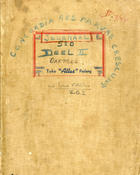 Lovers of Biggles and Indiana Jones will certainly enjoy reading about de Bruijn’s adventures.
Lovers of Biggles and Indiana Jones will certainly enjoy reading about de Bruijn’s adventures.
“Vic“ de Bruijn was born in 1913 on a sugar plantation in Java and studied Indology in Leiden.
In 1939 he was appointed Controller of the Wisselmeren district in the Central Highlands.
He started to explore the area that had been discovered only recently, and formulated some guidelines for explorers:
Government tasks all revolve around the mental coaching of these people, the simplest Dutch subjects. I would advise the newcomer to bring an infinite reservoir of patience. You will need it! Try to win the people’s confidence. This can be achieved in various ways. First of all, make yourself acquainted with the language; that will make things a lot easier. Join their parties, make jokes with the men. They like obscene jokes most of all. Make them laugh, don’t let them mope. Show some interest in their tribe, clan, family. […] Apart from the missus, pigs are the most precious possession of the mountain people. […] Make clear that you are not a ghost, but a human […] that you eat, urinate, defecate like them […] that you, too, have a penis to cohabitate […] (De Bruijn papers no. 2)
 Between 1942 and 1944 de Bruijn led an intelligence mission codenamed Oaktree, run by the Netherlands Forces Intelligence Service (NEFIS).
Between 1942 and 1944 de Bruijn led an intelligence mission codenamed Oaktree, run by the Netherlands Forces Intelligence Service (NEFIS).
NEFIS was based in Melbourne and collected information about the Japanese on behalf of the Allied Forces.
The Japanese had occupied New Guinea in 1942. De Bruijn formed a group of 38 people, including 29 local woodsmen and a Dutch radio operator, to monitor and report on Japanese activities in the jungle.
He acquired hero status as Jungle Pimpernel.
 "26 July 1944, Hagers Lake. 8.30 a.m. exactly, 2 Cats [ = Catalinas, water planes] skim over the lake, somewhat later our B25 (bomber plane) is buzzing across.
"26 July 1944, Hagers Lake. 8.30 a.m. exactly, 2 Cats [ = Catalinas, water planes] skim over the lake, somewhat later our B25 (bomber plane) is buzzing across.
No word is spoken. We just watch the Cats circling around the lake and the fighter-bomber up in the air.
How comforting to have these Dutch planes so near.
The Y87 is the first to land, then the Y 45 […]The boarding procedure of 15 group members, 28 Papua lifeguards, the radio gear, starts with two rubber boats and is soon finished […]
The Y87 is back in the air within 20 minutes. Strange to find myself here in the cockpit with a bread roll and a cup of coffee.
No more nightmares about being trapped by the Japs […] the evacuation has succeeded: 43 men are safe in our Dutch Cats!”(J.V. de Bruijn archive, no 2)
 The successful evacuation ended Oaktree. Thanks to another military operation, Reckless, the presence of the Japanese in New Guinea ended de facto in mid-1944. Operation Reckless was D-Day for New Guinea. On 22 April 1944, 52,000 American troops landed in Hollandia (footage at Youtube).
The successful evacuation ended Oaktree. Thanks to another military operation, Reckless, the presence of the Japanese in New Guinea ended de facto in mid-1944. Operation Reckless was D-Day for New Guinea. On 22 April 1944, 52,000 American troops landed in Hollandia (footage at Youtube).
Among them was a certain Lieutenant John F. Kennedy, who would later, as President of the United States, put pressure on the Dutch government to hand over New Guinea to the Indonesians.
Jean Victor de Bruijn Archive at the IISH; J. V. de Bruijn, Het verdwenen volk (1978); Anthony van Kampen Trilogie Jungle (1948-1951); Lloyd Rhys, Jungle Pimpernel (1947)
